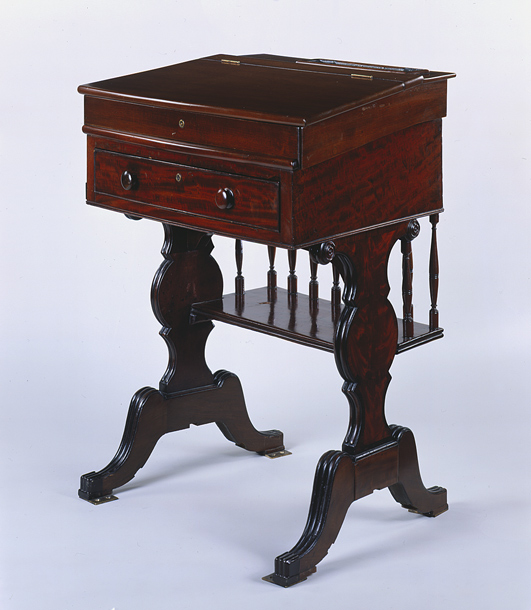
| Title | Desk, Senate Chamber, 66 (LXVI) |
| Artist/Maker | T. Constantine and Co. |
| Date | 1819 ca. |
| Medium | Mahogany |
| Dimensions | h. 35.25 x w. 28.38 x d. 19.69 in. (h. 89.5 x w. 72.1 x d. 50 cm) |
| Credit Line | U.S. Senate Collection |
| Accession Number | 66.00066.001 |
This mahogany writing desk was made specifically for use in the Senate’s legislative chamber in the U.S. Capitol, and is one of 100 desks that are similarly constructed and used daily by senators. It features two shaped and fluted legs, a bookshelf supported by mahogany spindles, a drawer, a hinged writing top with storage, and a removable wooden tray for writing tools. Decorative enhancements, including figured mahogany veneers and circular roundels, reflect the designs of the original 48 desks created for the Senate in 1819 by the New York cabinetmaking firm T. Constantine & Co. Over the years, many senators have inscribed their names in the interior of the desk drawers, making each drawer a unique way of linking current and past desk users. Desk occupants can change every two years with a new Congress, and are based on seniority.
Thomas Constantine (1791–1849) was born in Derbyshire, England, and he and his family immigrated to New York City when he was two. Between 1806 and 1812, Constantine apprenticed with New York City cabinetmaker John Hewitt, and then served as a journeyman in the same shop between 1812 and 1814. Thomas opened his own cabinet shop in 1815, and in 1817 his firm, T. Constantine & Co., began competing with some of the city’s most notable furniture manufacturers.
Constantine received his most celebrated commissions as Congress prepared to reoccupy the U.S. Capitol after it had been damaged by fires set by British soldiers in August 1814. In 1818, Constantine received a contract to provide the House of Representatives Chamber with carpets, wall hangings, lamps, 192 chairs, and 51 tables. The following year, Constantine was awarded a contract to furnish the Senate Chamber with 48 mahogany armchairs and desks, as well as other furnishings, lighting, and textiles. Constantine’s brother, John (1796–1845) is known to have assisted with the upholstery of the chairs made for both chambers.
Although scholars consider Constantine’s work for the House and Senate to be the apex of his relatively brief career, T. Constantine & Co. produced furniture into the 1820s. He closed his furniture store in the summer of 1824 and furniture manufactory in 1826. Today furnishings by T. Constantine & Co. are represented in various collections, including the National Park Service, National Museum of American History, North Carolina Museum of History, U.S. House of Representatives, and Winterthur Museum.
For more information on Thomas Constantine, see Matthew A. Thurlow, “Aesthetics, Politics, and Power in Early-Nineteenth-Century Washington: Thomas Constantine & Co.’s Furniture for the United States Capitol, 1818-1819" in American Furniture (Chipstone Foundation, 2006).